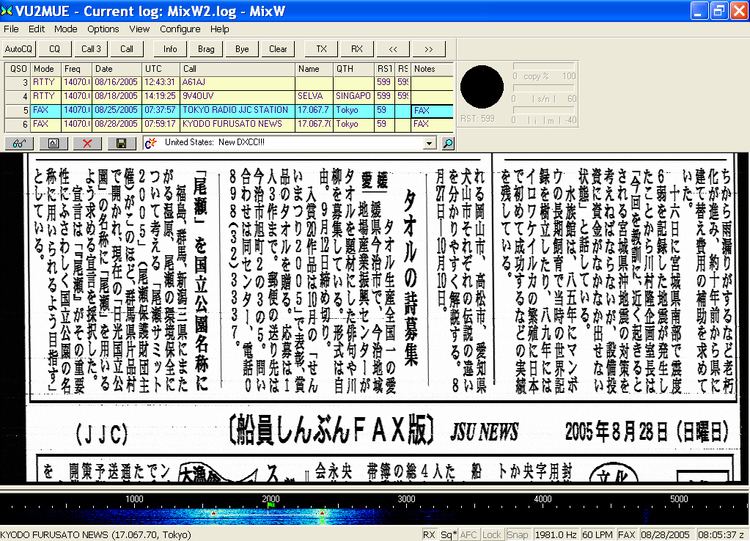 | ||
Radiofax, also known as weatherfax (portmanteau word from the words "weather facsimile") and HF fax (due to its common use in the short waves), is an analogue mode for transmitting monochrome images. It was the predecessor to slow-scan television (SSTV). Prior to the advent of the commercial telephone line "fax" machine, it was known, more traditionally, by the term "radiofacsimile". The cover of the regular NOAA publication on frequencies and schedules states "Worldwide Marine Radiofacsimile Broadcast Schedules".
Contents
Facsimile machines were used in the 1950s to transmit weather charts across the United States via land-lines first and then internationally via HF radio. Radio transmission of weather charts provides an enormous amount of flexibility to marine and aviation users for they now have the latest weather information and forecasts at their fingertips to use in the planning of voyages.
Radiofax relies on facsimile technology where printed information is scanned line by line and encoded into an electrical signal which can then be transmitted via physical line or radio waves to remote locations. Since the amount of information transmitted per unit time is directly proportional to the bandwidth available, then the speed at which a weather chart can be transmitted will vary depending on the quality of the media used for transmission.
Today radiofax data is available via FTP downloads from sites in the Internet such as the ones hosted by the National Oceanic and Atmospheric Administration (NOAA). Radiofax transmissions are also broadcast by NOAA from multiple sites in the country at regular daily schedules. Radio weatherfax transmissions are particularly useful to shipping, where there are limited facilities for accessing the Internet.
The term weatherfax was coined after the technology that allows the transmission and reception of weather charts (surface analysis, forecasts, and others) from a transmission site (usually the meteorological office) to a remote site (where the actual users are).
Transmission details
Radiofax is transmitted in single sideband which is a refinement of amplitude modulation. The signal shifts up or down a given amount to designate white or black pixels. A deviation less than that for a white or black pixel is taken to be a shade of grey. With correct tuning (1.9 kHz below the assigned frequency for USB, above for LSB), the signal shares some characteristics with SSTV, with black at 1500 Hz and peak white at 2300 Hz.
Usually, 120 lines per minute (LPM) are sent (For monochrome fax, possible values are: 60, 90, 100, 120, 180, 240. For colour fax, LPM can be: 120, 240). A value known as the index of cooperation (IOC) must also be known to decode a radio fax transmission - this governs the image resolution, and derives from early radio fax machines which used drum readers, and is the product of the total line length and the number of lines per unit length (known sometimes as the factor of cooperation), divided by π. Usually the IOC is 576.
Automatic Picture Transmission format (APT)
APT format permits unattended monitoring of services. It is employed by most terrestrial weather facsimile stations as well as geostationary weather satellites.
Stations
Today, radiofax is primarily used worldwide for the dissemination of weather charts, satellite weather images, and forecasts to ships at sea. The oceans are covered by coastal stations in various countries.
In the United States, fax weather products are prepared by a number of offices, branches, and agencies within the National Weather Service (NWS) of the National Oceanic and Atmospheric Administration (NOAA).
Tropical and hurricane products come from the Tropical Analysis and Forecast Branch, part of the Tropical Prediction Center/National Hurricane Center. They are broadcast over US Coast Guard communication stations NMG, in New Orleans, LA, and NHC, the Pacific master station on Point Reyes, CA. After Hurricane Katrina damaged NMG, the Boston Coast Guard station NMF added a limited schedule of tropical warning charts. NMG is back at full capability, but NMF continues to broadcast these.
All other products come from the Ocean Prediction Center (OPC) of the NWS, in cooperation with several other offices depending on the region and nature of information. These also use NMG, NMC, and NMF, plus Coast Guard station NOJ in Kodiak, Alaska, and Department of Defense station KVM70 in Hawaii.
Ever since the RMS Titanic dramatized the dangers of icebergs in the North Atlantic, an International Ice Patrol has also originated weather data, and its charts are broadcast by the Boston station during the prime iceberg season of February through September, using the callsign NIK.
A major producer of Canadian radiofax is the Canadian Forces METOC (Meteorology and Oceanography Centre) in Halifax, NS, using the communication station CFH. Charts are sent on the hour, then the station switches to radioteletype (RTTY) for the rest of the period.
CBV, Playa Ancha Radio in Valparaiso, Chile broadcasts a daily schedule of Armada de Chile weather fax for the southeastern Pacific, all the way to the Antarctic. Also in the Pacific, Japan has two stations, as does the Bureau of Meteorology in Australia. Most European countries have stations, as does Russia.
Kyodo News is the only remaining news agency to transmit news via radiofax. It broadcasts complete newspapers in Japanese and English, often at 60 lines per minute instead of the more normal 120 because of the greater complexity of written Japanese. A full day's news takes hours to transmit. Kyodo has a dedicated transmission to Pacific fishing fleets from Kagoshima Prefectural Fishery Radio, and a relay from 9VF, possibly still in Singapore. The frequencies formerly used by JJC radio outside Tokyo are now sent from an unknown location, using the same identification in Japanese as 9VF. They are still active and heard daily in 2010.
